
JAMES R. ARNOLD
TET OFFENSIVE 1968. TURNING POINT IN VIETNAM
Hack in the city, the difficult house-to-house fighting frustrated the Allied commanders. Prohibitions on the use of artillery and air strikes, intended to preserve historic sites within Hue, coupled with poor weather limited Allied progress. On 9 February, a reporter asked the commander of the 1st ARVN Division whether the Imperial Palace, which served as a defensive strongpoint, was not too important to bomb. General Truong pragmatically replied: 'You exaggerate. It is good for tourists, but if we meet heavy resistance we will use air strikes, artillery, everything.'
Still, the poor weather and the special Rules of Engagement employed in Hue meant that the Marines went without their customary fire support. Fortunately the big Patton tanks and the 106mm recoilless rifles provided accurate direct- lire weapons to reduce a sniper's lair or a machine- gun nest. First though, these positions had to be located, and this was usually done at cost. A Marine recalls watching a decimated platoon huddle beneath one of the ubiquitous garden walls. Several boosted one grunt over the wall. As his head reached the top a concealed AK-47 fired. The grunt flopped to the ground. He had been shot in the face. Crying out 'Momma!', he died.
By 10 February the Marines had cleared the South Side. Now they had to turn their attention to the Citadel across the river. Higher command back at Phu Bai remained badly out of touch with reality. For example, its plan called for crossing a bridge that had been destroyed by NVA sappers one week earlier. Although ARVN forces had cleared about three-quarters of the Citadel, the NVA still held formidable positions and retained a functioning supply line to their strongholds in the western mountains. In addition they struck back with bold counter-attacks whenever possible. Indicative of their fighting spirit was a spectacular nocturnal raid by VC combat-swimmers, who mined another important river bridge and dropped two of its spans into the water.
Reinforcements arrived for the drive against the Citadel. Vietnamese Marines, having just finished clearing Saigon of VC resistance, arrived to relieve the battered airborne battalions. The US 1/5 Marines entered battle on 12 February. The street fighting chewed the battalion up as witnessed by its losses among platoon leaders. After nine days of combat, its ten rifle platoons, which would normally be led by first lieutenants, were commanded by three second lieutenants, one gunnery sergeant, two staff sergeants, two buck sergeants, and two senior corporals.
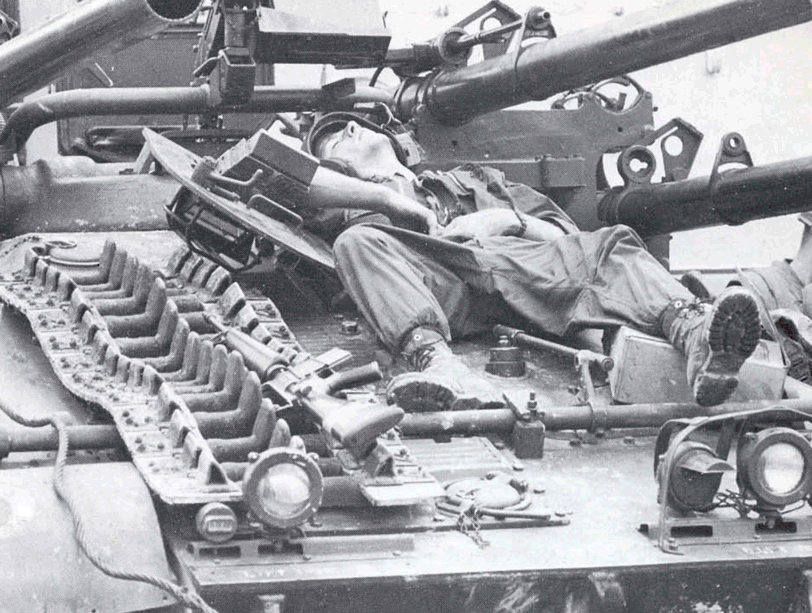
The exhaustion of this Marine is apparent as he sleeps on the deck of an Ontos, an anti-tank vehicle used for direct tire support and armed with six l06mm recoilless rifles.
On 26 February, soldiers moving through the Gia Hoi High School yard came across freshly turned earth. They investigated and uncovered the bound bodies of numerous civilians. They were the first of a colossal number of victims of a Communist atrocity, the dimensions of which were not fully appreciated until mid-1970 when the last graves were found. Around Hue, searchers eventually found 2,810 bodies, while nearly 2,000 more remained missing. Apparently the slaughter began when the VC first occupied Hue. Special commandos had rounded up and executed civilians on a blacklist of government workers and politicians. When it appeared that the Communists might be able to hold Hue, a second wave of executions took place. This time the victims were intellectuals and students who seemed to represent a threat to the new Communist order. When it became clear that the battle was going adversely, the largest number of killings occurred. The VC systematically killed anyone who might be able to identify the local Communists who had surfaced during the offensive. Following the mass killings, they tried to hide their work. Preoccupied by the ongoing combat the Allies failed to publicize the atrocity. The Press tended to disbelieve the early reports of mass graves, since these came from sources they considered discredited. Instead reporters concentrated on stories of Allied setbacks and pictures of the urban destruction.
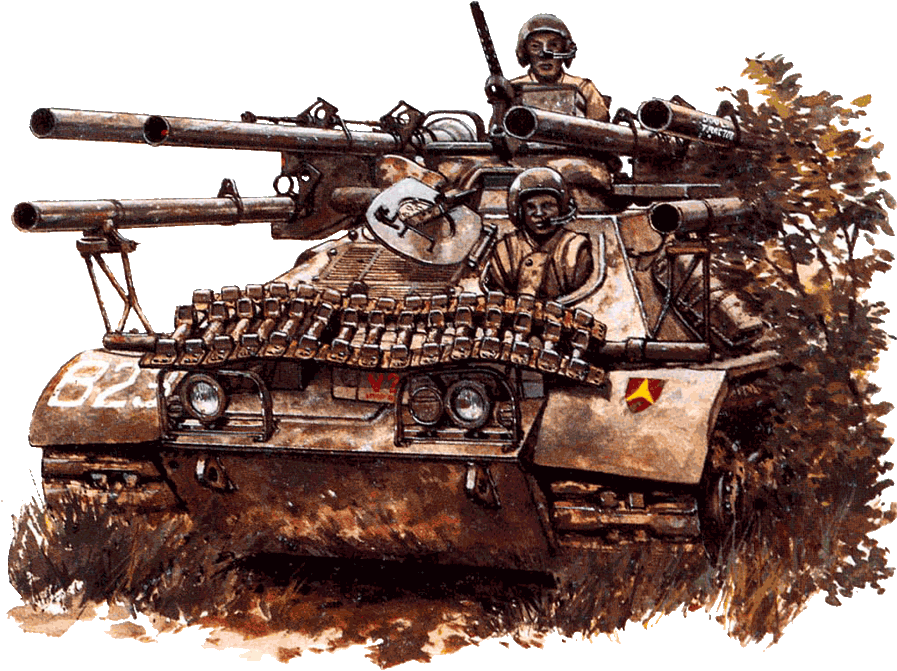
M50A1 Ontos of 3rd Anti-Tank Battalion, US Marine Corps. Illustration by Peter Sarson and Tony Bryan.
The difficulty of the first assaults against the Citadel equalled anything in Marine Corps history. Tanks could barely manage to operate in the narrow alleys near the Citadel's high walls and towers. Wide scale use of debilitating CS gas helped, but a day's advance frequently did not exceed 200 yards. The Marines paid in blood for most of these gains. During the week of 13-20 February, four Marine companies suffered 47 killed, 240 seriously wounded, and another 60 wounded who remained in combat. Casualties were so high that the Marines sent replacements directly from their instructional camps in the United States. Hopelessly maladroit for the complex city fighting, they died far too often. Yet the relentless advance by the flak-vested grunts forced the defenders to face the inevitable. On 16 February, radio intercept technicians decoded a message from the NY A commander inside Hue. It spoke of heavy losses, including the senior officer, and requested permission to withdraw. Communist HQ sent the reply to remain and fight.
By 21 February the Allies could see the end. The 1st Cavalry had managed to close the enemy supply lines into Hue. By the following day the US Marines could prepare for a final push and reported lighter enemy contact than on any previous day. Similarly, ARA N forces resumed the advance. By order of the high command, the Marines allowed the 1st ARVN Division's Black Panther Company - a unit that had fought long and hard, an exception, most Marines thought - to make the final assault. The Black Panthers charged right at the Imperial Palace, yelling and firing as they advanced, some carrying scaling ladders to get over the walls. NVA resistance had collapsed. The ARVN soldiers hauled down the Viet Cong flag that had flown for 25 days. Unaware of the ARVN contribution at Hue, a Marine officer bitterly observed: 'The MACV records will reflect that the ARVN... took the Citadel. That was strictly public relations hogwash... The 1st Battalion, 5th Marines, took the Citadel. The ARVN were spectators.'
Hue was the longest sustained infantry battle the war had so far seen. By Vietnam standards, losses had been high. During 26 days of combat ARVN units lost 384 killed and more than 1,800 wounded; US Army casualties were 74 dead and 507 wounded; the three Marine battalions, 142 and 857, respectively. The Allies claimed to have killed over 5,000 and captured 89. Civilian losses, both victims of Communist atrocity and hapless targets caught in the urban crossfire, amounted to some 5,800 killed. Much of the once-beautiful city of Hue lay in rubble.
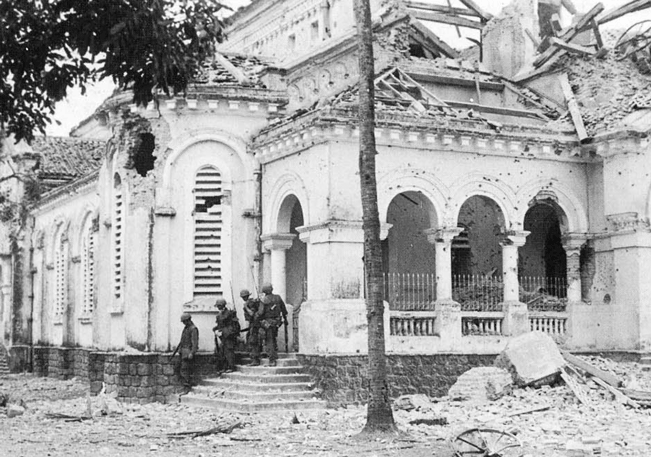
Grunts belonging to 'A' Company, 1/1 Marines, leave a recaptured church on 9 February.
During the preceding 25 years, the American military had made a habit of playing the victim for enemy surprise attacks. Pearl Harbor, Kasserine Pass, the Battle of the Bulge and the Chinese intervention along the Yalu River had all caught the Americans unawares. The synchronized violence of the Tet Offensive was matched perhaps only by the Germans' Ardennes Offensive. Of all these surprise attacks, only the Tet Offensive achieved decisive results.
Yet, by conventional military calculation, Tet was an enormous Allied success. At a cost of some 4,000 Americans killed and wounded and between 4,000 and 8,000 ARVN soldiers killed, the Communists suffered 40,000 to 50,000 battlefield deaths. Most importantly, large numbers of irreplaceable local Viet Cong fighters and cadres had died. Simply put, the enemy had concentrated, and his masses had been consumed by American firepower. This battlefield success has been obscured by the more important political consequences of the Tet Offensive. However, Tet was part of an unbroken record forged by the American soldier from 1965 to 1973 of not losing a single important battle. As Douglas Pike, one of the few experts to study and comprehend the Viet Cong and North Vietnamese, notes: 'Had the Vietnam War been another conventional war, had it been decided on the basis of past wars, it would have been over by mid-1968 with the defeat of the Communist forces.' Indeed, the way the public perceived the battle astonished many American veterans. Standing next to enemy corpses stacked like cordwood outside his unit's headquarters, a cavalry officer wondered how: 'To our complete bewilderment in the weeks that followed, nobody ever publicized this feat of battlefield triumph. Instead, we read that we had been defeated!'
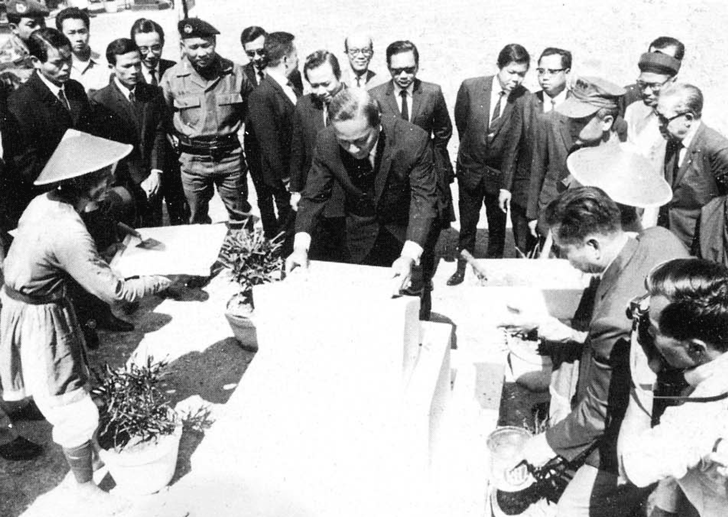
President Nguyen Van Thieu places a commemorative plaque for the victims of the Hue massacre in 1971.
It is also important to remember that the Communist strategists had designed the offensive to impress the South Vietnamese rather than the American public. A top North Vietnamese General, Tran Do, commented after the war:

'We didn't achieve our main objective, which was to spur uprisings throughout the south. Still, we inflicted heavy casualties... As for making an impact in the United States, it had not been our intention - but it turned out to be a fortunate result.'
In many ways the embassy battle was a microcosm of the entire war. The weapons and explosives used during the attack easily slipped past the hopelessly inadequate South Vietnamese security cordon around the capital. The guerrillas mustered in a building owned by a female Viet Cong agent of thirteen years' standing who had been arrested several times for subversive activities. Yet her building was not under surveillance. The attackers received help from an embassy driver, whom the Americans had often jokingly said 'must be a VC' because he was so smart. They drove past South Vietnamese police who ran rather than sound the alarm. In the attack the VC hardly proved supermen. They were inadequately briefed, opened fire too soon, and showed no initiative once their leaders fell.
Interestingly enough, the Communist high command had not appreciated the potential psychological impact of the embassy assault. It was just one, rather minor, target among many. In fact, the general who commanded the Saigon offensives criticized the embassy attack several days after it took place. He believed it had been poorly conceived. Only when they understood the attack's impact on the American public did the Communists begin to propagandize it. Here was the paradox of the war: a small, ill-conceived, tactically flawed attack against an insignificant military objective, designed to impress the South Vietnamese, proved the decisive action of the war because of its impact on the American public.
Communist planners had timed the offensive for a holiday period when the South Vietnamese and Americans would be less vigilant. Conveniently, it was also at a critical time in the United States. It was just before the first presidential primaries and thus, in the words of Don Oberdorfer, 'caught the American political system at its moment of greatest irresolution and potential for change'. Incomplete, inaccurate, and biased Press coverage of the combat influenced the public's perception. However, even if this type of coverage were discounted, the public recognized by the widespread and ferocious nature of the Tet Offensive that the enemy remained much stronger than their politicians and generals had led them to believe. The choice seemed to be to escalate yet again or to seek terms.
The first option seemed unpromising because strategically the Tet Offensive undercut Westmoreland's attrition strategy. The essential weakness of this strategy should have been apparent before Tet. In mid-1967 the NVA comprised some 450,000 men of whom a mere 70,000 served in Laos and South Vietnam. Each year about 200,000 young men reached the age of eighteen. Simple arithmetic could show that the Communists had the manpower to endure the kind of terrible losses they suffered in 1967 for years to come. If attrition strategy could not kill the enemy fast enough, in spite of amazing favourable kill ratios of 10 to 1 or better, then the outcome hinged on will. Recent history" against the French, let alone the long history of Vietnamese resistance to the Chinese, clearly demonstrated that Communist morale, which had assumed the mantle of stubborn Vietnamese nationalism, would not crack.
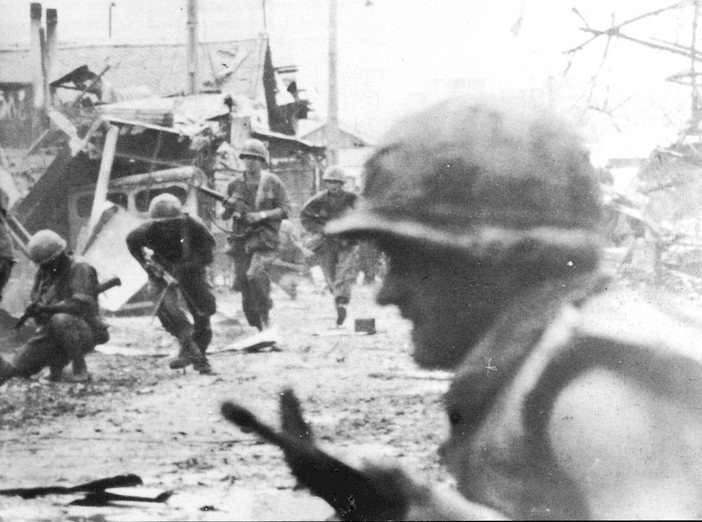
The 'Mini Tet' Offensive in May brought a return to street lighting in Saigon.
If escalation would not work, negotiation seemed the only alternative. Many historians point to the night of 27 February 1968 as a turning point in the war. That evening, the popular and much- respected American broadcaster Walter Cronkite delivered a televised special report summing up the Tet Offensive. Cronkite had just returned from a whirlwind tour of South Vietnam and what he had seen had greatly depressed him. He began his report in the most despairing manner. While the camera panned over battle damage in Saigon, he intoned that the ruins 'in this burned and blasted and weary land... mean success or setback, victory or defeat, depending on who you talk to'. He proceeded to juxtapose official comments minimizing setbacks with selected eyewitness accounts that claimed disaster. He left no doubt what he personally felt, using such terms as 'the shattered pieces' of pacification, stating that the South Vietnamese government 'could salvage a measure of victory from defeat'. His interviews and film seemed to discredit all official pronouncements. Cronkite concluded:
'We have been too often disappointed by the optimism of the American leaders... To say that we are closer to victory today is to believe, in the face of the evidence, the optimists who have been wrong in the past... To say that we are mired in stalemate seems the only realistic, yet unsatisfactory, conclusion... it is increasingly clear to this reporter that the only rational way out will be to negotiate, not as victors, but as an honorable people who lived up to their pledge to defend democracy, and did the best they could.'
Initially, Press reports including Cronkite's did. little to alter the public's attitude toward the war.
Whereas before Tet 45 per cent believed that sending American troops to Vietnam was a mistake, 49 per cent felt this way after Tet. More important, the extremely influential Eastern television and print media moguls, and substantial numbers of the Washington, DC, opinion makers and politicians, concluded that the war was lost. They began to disseminate this message to the country, and the public listened. Consequently, February and March led to a turning point in American opinion about the war. During the two months following Tet, one in every five Americans switched from pro- to anti-war. Johnson's popularity among both pro- and anti-war people plummeted. Public frustration encompassed roughly equal numbers of hawks - who were angered at the administration's half-measures that seemed only to produce more dead American boys - and the doves who simply wanted to get out.
The American Press played a decisive role in the Tet Offensive. Yet, in both detail, analysis and conclusion, Press reporting of the Tet Offensive was highly misleading. An inexperienced, or lazy, reporter covering the war from the comfort of Saigon could not understand how the Communists had been able to mass for their surprise assaults without detection. They reported that it must be because of a sympathetic civilian population who helped conceal Communist movements. Here was more evidence, ran a common Press refrain, to undermine the administration's claims about the war's progress.
In fact, the majority of the South Vietnamese civilian population was neutral, more interested in survival than anything else. The Communists needed little assistance beyond that provided by their local cadres, who represented a small percentage of the total population. The terrain provided the rest. Even Saigon lay surrounded by swamps, woods and canals. The Communists took advantage of this concealment to march in secret to staging areas on the city's outskirts. But this important fact was unknown to the majority of the Press and so remained unreported to the public. The public could only conclude that an obliging citizenry had escorted the enemy to the gates of the American bases. Similarly, the Press had few contacts within the South Vietnamese military.
The handful of reports that did focus on ARVN performance highlighted those units and leaders who had fought the poorest. This message reinforced the growing sense that America fought alone.
At the time, political and military leaders from Johnson and Westmoreland down blamed the Press for losing the war. The effort continued for years thereafter as discredited leaders sought to recover prestige. But their carping obscures the fact already described that even with a fully muzzled Press America had no viable war-winning strategy.
By the end of March the domestic sea change led to the announcement by the proud, enbittered President Lyndon Johnson that he would not run for re-election. In an effort at negotiated settlement, Americans and North Vietnamese met in Paris in mid-May 1968, some three months after Tet. American leaders never fully comprehended the masterful Communist negotiating strategy of 'fighting and talking'. More Americans would be killed after the 'peace talks' opened then before they began.
On 3 July, General William Westmoreland departed as MACV commander to become the new Army Chief of Staff. Few doubted that, defeated and discredited, he had been kicked upstairs. Responding to domestic political pressure, his replacement - General Creighton Abrams - ordered sweeping strategic changes. American tactical aggressiveness gave way to the new mandate to reduce American battlefield casualties. Equally important, the high command decided that, henceforth, South Vietnamese troops would switch from pacification to mainstream combat. This decision, formally announced by the Joint Chiefs of Staff on 16 April 1968, marked the beginning of what would become the ill-fated 'Vietnamization' policy. Thus the Tet Offensive achieved a certain symmetry of results: it destroyed the Viet Cong but caused the Americans to begin to disengage as they turned the war over to the South Vietnamese. The future would depend on the contest between the regulars of North and South Vietnam.
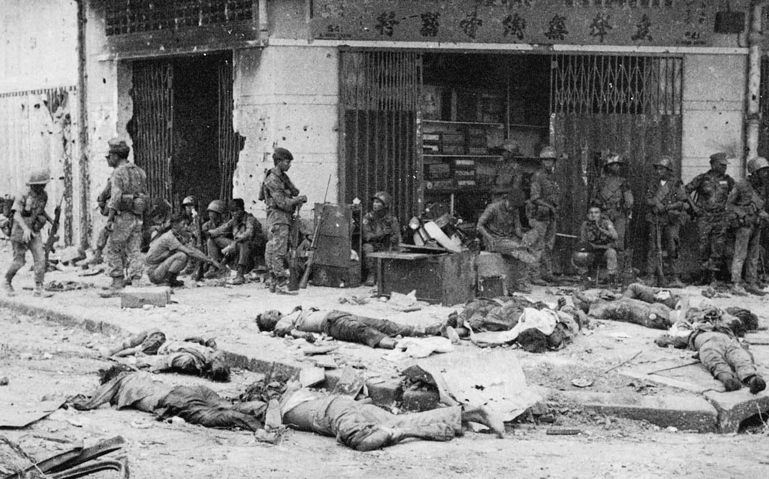
Scenes of urban death and destruction once again provided film for television cameras. Vietnamese Rangers collect the bodies of slain Met Cong in June 1968.
Meanwhile, in selected areas American soldiers would continue offensive operations. But the nature of the war changed. Abrams, much to the disgust of more junior, hard-charging officers, responded to new political realities by emphasizing city security. He badly wanted to avoid a repeat of the Saigon and Hue battles. The need to defend cities took manpower away from offensive action. None the less, adequate ARVN-US planning for Saigon's defence did not take place until after the second major Communist assault exploded through the capital in May.
The Tet Offensive demonstrated to many the essential dilemma the American military faced in Vietnam: 'Guerrillas win if they don't lose. A standard army loses if it does not win.' Even this comment obscures the most important facet of the war: first and foremost it was a political struggle. The Communists clearly recognized this from the beginning and wove an integrated military/political war-winning strategy. American politicians refused to mobilize the political will of the country, meddled with military strategy- to its profound detriment but, in the end, listened to the generals who claimed they could conquer on the battlefield. The military, in turn, did not appreciate the political consequences of what it did. They had some understanding of domestic American consequences, but little regard for the impact of operations on the citizens of Vietnam. A North Vietnamese officer, explaining why America lost, put it most plainly: 'Your second weak point was to try to win the hearts and minds of the people while you were using bombs to kill them.'
During the Tet Offensive the American military had achieved notable successes and suffered some important failures. In spite of advance warning, Westmoreland had failed to alert adequately all units before the enemy assault. He was caught in mid-shift of major formations northward. He underestimated the psychological importance of Saigon and Hue. He failed to establish a coordinated ARVN-US plan for city defence.
Tactically, the surprise offensive caught the Allies short of weapons and lacking appropriate tactics for urban warfare. The military- had consciously discarded many of the heavier weapons associated with conventional combat in order to improve mobility in Vietnam's hinterland. Suddenly forced into tough house-to-house fighting, soldiers found themselves without direct-fire heavy weapons such as the Marine's 106mm recoilless rifle. They had to rely upon helicopter gunships, air strikes and artillery, all of which were less accurate and increased destruction of civilian life and property.
Tet was a major setback for the slowly improving South Vietnamese military. Along with their advisers, ARVN units fought unaided on the ground in 36 of 44 provincial capitals, 64 of 242 district capitals, and 50 hamlets attacked at the beginning of Tet. The best units acquitted themselves very well during the fighting. Some poorly regarded divisions fought much better then expected. Others, such as the 2nd Division at Quang Ngai which had been judged combat effective, displayed little fighting spirit. Overall, the units that fought the best suffered serious losses and declined as a result of Tet. The official casualty count probably understated South Vietnamese losses: 4,954 killed, 15,097 wounded, 926 missing. Unofficial estimates counted at least double this total of soldiers killed.
The stunning violence of the Communist assault demonstrated to South Vietnamese civilians that their own government, supported by the Americans and despite their weapons and promises, could not protect them. The Communist occupation of the old Imperial City of Hue had an adverse impact on South Vietnamese morale comparable to the American public's reaction to the embassy attack. Nation-wide war-weariness set in and desertion rates soared. At the end of 1967 the desertion rate was 10.5 per thousand. After heavy fighting and new mobilization orders, the July 1968 rate was 16.5 per thousand. Some 13,506 men deserted in July alone.
The Tet Offensive was also a bad setback for the pacification effort. More than one-third of the ARVN regular battalions assigned to pacification in rural areas had to withdraw into nearby cities. In the absence of protection, half the rural development teams, who had been making some progress at winning popular support for the government, abandoned their villages. These teams were the lynchpin of the pacification effort, which, in turn, was fundamental to Allied strategy.
From the Communist perspective, on the battlefield Tet had achieved far less than had been hoped. The Hanoi command had seemingly overestimated the readiness of the southern people to rise and overthrow the government. Giap had apparently yielded to impatience and misjudged the situation. The months following the offensive witnessed a doctrinarial debate within the Hanoi Command. A key conclusion was that victory could be achieved by remaining in Mao's Stage Two of guerrilla war without ever massing for Stage Three combat. This conclusion was a dramatic departure from previous doctrine.
The war would now be won by the 'super- guerrilla'. This fighter was anything but the black-pyjama-clad, lightly armed, local guerrilla. Rather he was a well-trained fighting man armed with the best weapons jthat the Communist world could provide. He used modern communications equipment to co-ordinate his effort, and would conduct deadly raids against enemy installations in order to limit the enemy's initiative and wear him down. Doctrine aside, however, such were the Tet losses that the Communists were unable to launch any major attacks during 1969.
The Tet Offensive, along with the subsequent summer offensives, nearly annihilated the Viet Cong. The VC suffered irreplaceable losses among key leaders and agents. As one survivor lamented: 'We lost our best people.' Henceforth, the North Vietnamese would have to bear the brunt of all combat operations. Combined VC/NVA casualties had been so severe that they required four years to recover before launching another major offensive. Even then, the Easter offensive of 1972 relied upon NVA soldiers for 90 per cent of the combat.
Given the important differences between Hanoi's and the National Liberation Front's objectives, the destruction of the Viet Cong was not entirely unwelcome in the North. The Offensive killed off many leaders who might have challenged Northern hegemony. Events after the war support this dark view of Hanoi's strategy. Many surviving high-ranking Viet Cong were terribly disheartened at what befell their movement. They felt betrayed by their northern brothers. Some had to flee the county. Northern historians, on the other hand, minimized the importance of the VC's contribution. Some virtually denied that the NLF and the VC had much to do with the war. While as of 1989, Hanoi has apparently solid control over the country, according to reports from people who flee the country, strife between north and south still simmers beneath the surface. From the Viet Cong perspective, Tet must be seen as a terrible bloodbath, a catastrophic defeat.
For the North Vietnamese, Tet marked the turn of the tide. But this was not readily appreciated at the time. Responding to a question of whether the High Command knew they had won the war in 1968, a general replied: 'Yes and no. Nixon began the withdrawal, but Vietnamization was a difficult period for us... 1969 and 1970 were very hard on us. The fighting was very fierce.'
While Communist post-mortems of many of the attacks, particularly those in Saigon, were full of honest self-criticizm, Hue was deemed a battle whose 'most outstanding feature was that we won an overall success'. The Communist command was particularly pleased to note that 'Hue was the place where reactionary spirit had existed for over ten years. However, it took us only a short time to drain it to its root.' Without apologies, such was the Viet Cong view of civilian massacre.
Whether the Communists could have endured an Allied counter-offensive during 1968 of the type proposed by Westmoreland is one of the tantalizing 'what ifs' of the Vietnam War. But as memories of the war's horror fade with time, and generals propound theories on how it could have been won, recall the words of a North Vietnamese officer who acknowledged the terrible losses suffered during Tet: 'We had hundreds of thousands killed in this war. We would have sacrificed one or two million more if necessary.'
The Tet Offensive of 1968 failed to defeat the American combat soldier on the battlefield, but it had defeated his general's strategy, his political leaders, and reversed the support of the people back home. It was one of the few battles of history that can be called decisive.
We have much more interesting information on this site.
Click MENU to check it out!
∎ cartalana.com© 2009-2025 ∎ mailto: cartalana@cartalana.com